I never had any particular interest in Indonesia, but the sheer virtue of being at Wesleyan and then at the East West Center – both with strong communities of Indonesians and researchers on Indonesia – gave me a casual education about the country’s cultural riches: shadow puppet theater, carving and woodwork, gamelan music, Javanese dance. My trip took me to the 2 powerhouses of Javanese culture: Solo (Surakarta) and Jogyakarta. I watched a ballet of Ramayana in the open air theater set against the gorgeous backdrop of the thousand year old Prambanan temple. A few days later, I sat through a two hour shadow puppet play (also of Ramayana) despite not understanding a thing that was going on even though I knew the story quiet well, for an outsider at least.
A more accessible heritage to the common tourist is batik. And like many visitors to Solo, Indonesians and foreigners alike, I spent the whole afternoon wandering around the traditional batik neighborhood Kampung Kauman. While the myriads of motif appealed to my taste for the colorful and floral, the fabric was just standard cotton or silk. I’m a sucker for fine textile, so I hastily concluded that it wasn’t that special after all.
And how wrong was I! Solo is the hometown of Santosa Doella, the owner of the premium batik brand Danar Hadi, who opened a museum dedicated to this art next to the flagship shop on the city’s main boulevard. I had the morning free before taking the bus from Solo to Jogya and decided to check it out. The guided tour cost a modest $2 and it was easily the best tour I’ve ever had. The diverse influences on the evolution of batik art was a big surprise: from European colonists to Chinese settlers to Indian, Arabic, and Persian traders, each group brought stories and images from their homelands. I also learned how to differentiate batik used for different royal houses and in different functions. Needless to say, the collection of the biggest name in the industry was full of mesmerizing pieces, leaving me awed as I followed my guide from one section to the next.
But the most impressive is the production. It is a long, labor intensive process that involves multiple steps drawing and putting waxes on and off the entire fabric, and then dying it one color at a time.It’s not easy to explain in words. Even though I was toured around with all the tools in front of me and looking at artisans working live, it still took me many a clarifying questions to “get” it. For example, if you have a figure 8, and you want to dye it in the following scheme: blue for number 8 itself, black on the exterior, and beige on the interior. You’d put wax on the outside and the inside of the number 8 , dye the fabric blue. When you take the wax off, you’d have the blue 8. Next, put wax over the exterior, and over the number, dye the fabric beige (for the interior). Repeat the process of taking wax off, applying it again, this time over the blue 8 and the beige interior, now you can dye to exterior black. It is so time and labor consuming that a skilled artisan at Danar Hadi, using the accelerated method of stamping (saving them the first 2 steps of drawing and putting wax over the motif) can only produce 2 pieces a day.
I was really surprised at how “primitive” the factory was. It was hot and crowded and loud, in sharp contrast to the quiet air-conditioned and sparkling showroom and museum. Luck was on my side; the workshop here was running in its last days before being moved the week after. Indeed on the men’s section, they’d already packed up all the stamps and ready to go.
The result of all this education? Right after I arrived in Jogya, I took off immediately to Mirota, an enormous batik shop, and picked up a few pieces. It is truly unique, and I consoled myself that I wasn’t shopping for clothes, but for arts.
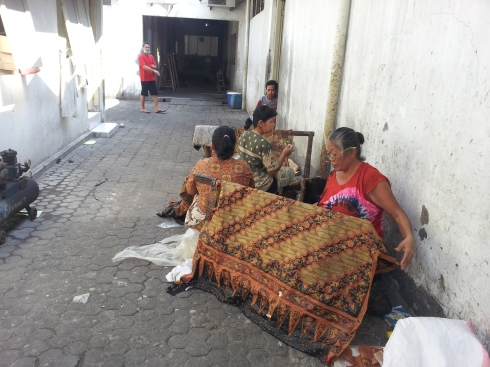
a typical court batik: the colors are somber, and the motif parang, likened to the wavy kris dagger, was once reserved for the royalties

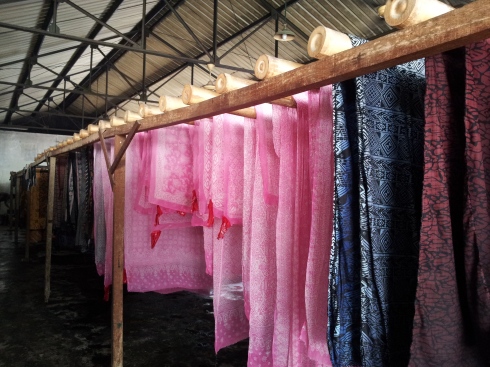
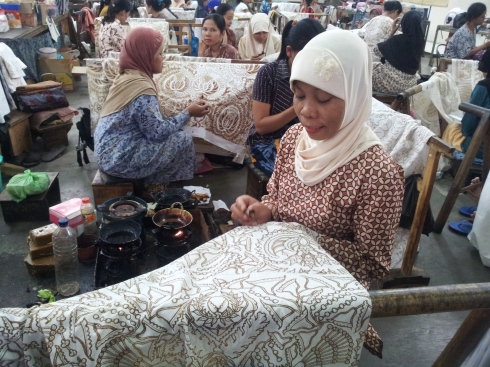
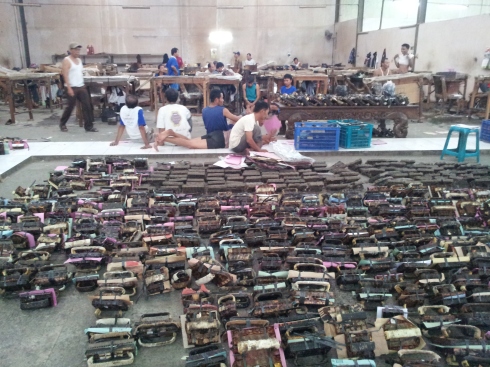
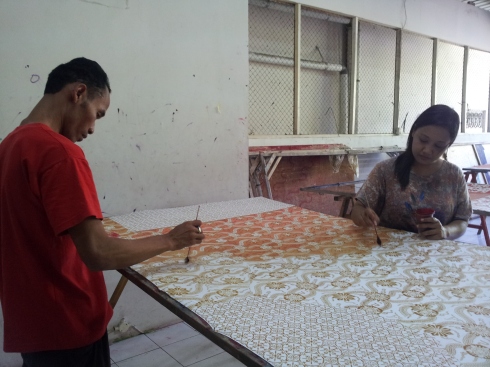
Leave a comment
Comments feed for this article